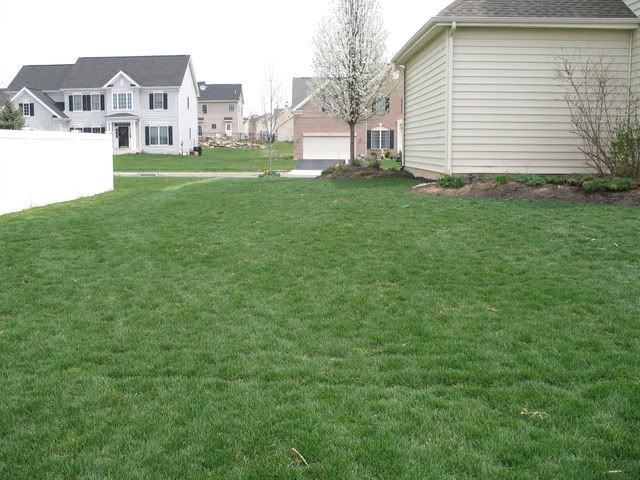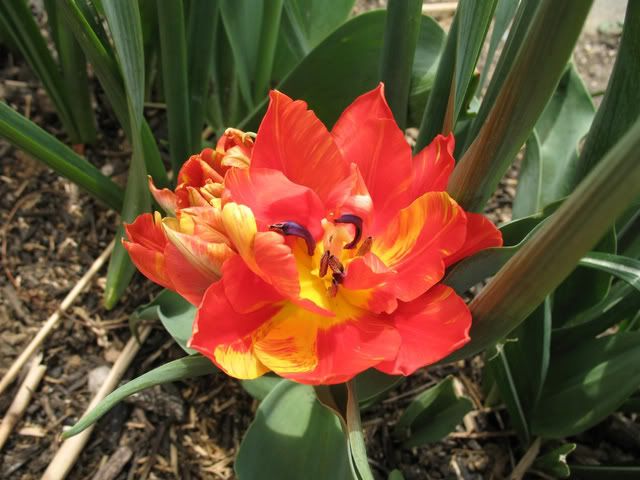I'd applied a considerable amount of iron last week and the color deepened, but the new growth is already becoming considerably lighter. With soil tests of 1.4 ppm iron, I'm not terribly surprised.
I applied another 72 pounds of Milorganite and 60 pounds of Ironite to get my iron levels up a little higher. It looks like I'll need to do that again in two weeks as the levels now should be measuring around 9 ppm which is still too low.
Thursday, April 30, 2009
More Milorganite and Ironite
Thursday, April 23, 2009
Soil Test Results
The University of Massachusetts test results of my lawn soil are back:
pH: 7.2 (a touch high...3.2 point shift in 3 years)
Buffer pH; 7.1
N: 10 ppm (organic lawn)
P: 9 ppm (a bit low)
K: 321 ppm (off the charts)
Ca: 3185 ppm (way off the charts)
Mg: 269 ppm
Ca/Mg Ratio: 11.8 (thoroughly wrong)
Organic Matter: 4.6% (up from 0.1%)
CEC: 15.9 Meq/100g
Aluminum: 19 ppm
Boron: 0.4 ppm
Manganese: 7.0 ppm
Zinc: 1.8 ppm
Copper: 0.5 ppm
Iron: 1.4 ppm
Sulfur: 45.7 ppm
Soluble Salts: 0.26 dS/M (normal range 0.08 - 0.50)
Percent Base Saturation: K: 4.4, Mg: 11.7, Ca: 84.1 (Ca/Mg ratio here is 7.1, though)
Lead: Undetectable
The soil pH is OK given the amount of raw organic material I apply and it'll drift down in a year or two as I back off and the fungal mass drops. Kicking in a little P (phosphorus) is a good idea. Iron's very low, so Milorganite would be a good addition to get both iron and P. I should ignore any potassium sources for the remainder of the year as that's quite high.
A whisper of boron is a good idea, too, but not much.
I've applied 7 bags of Milorganite for iron and phosphorus, plus I broke down and put down 3 bags of Ironite (which I would rather not repeat but will probably have to). I also purchased 20 Mule Team Borax, diluted 1 teaspoon in 1 quart of water in my sprayer and applied that over 1,000 square feet of the lawn with around 20 gallons of water dilution on top of that. That should bounce the boron levels a touch.
Sunday, April 19, 2009
Photo Update!
 Here's an updated image from today. The color is greening, although density is still increasing only very slowly.
Here's an updated image from today. The color is greening, although density is still increasing only very slowly.
As always, click to embiggen any photo.
Bonus shots! Here's the back garden, plus two closeups:


Tuesday, April 14, 2009
Fifteen Thuja standishii x plicata (Green Giant Thuja)
We'd like a bit more privacy on the back line, plus something that will stay evergreen and give a bit of wind protection. Thuja standishii x plicata, Thuja Green Giant, fit that bill perfectly. Our local nursery, Glenmar, promised 2 gallon, 2 foot plants. We got 2 gallon, 3 foot or taller plants, so I'm very pleased and the price was extremely reasonable at around $27 per shrub. Glenmar always has incredibly healthy plants and the prices are good.
Fifteen of those are now on the back line, one every five feet for a faster privacy screen and to limit their adult height and width. They shouldn't go taller than 20 feet, whereas a single specimen can get very wide and 40 feet tall.
For soil preparation, I used six small handfulls of corn meal mixed with a bit of alfalfa and a small amount of kelp meal in around thirty cubic feet of soil (per plant). That was mixed in to the soil and the holes were dug about 2' away from the bushes to give them a clear field with no competition. I didn't dig any deeper than the root mass to give them a solid base.
Advertising says they grow three to five feet per year, but that tends to be once they're established. Starting at 3 feet, I don't expect much more than six inches of growth this year, 18" next year, and then they should begin to grow quickly.
If you have questions about Thuja, visit the Bestlawn forum and use the Around the Yard section. You can sign up for free, and they have people who know a lot more than I do.
Sunday, April 5, 2009
Certainty on P. annua (Annual Bluegrass) and More
I sprayed Certainty at the recommended rate of 0.75 ounces per acre (although I spot-sprayed) on some P. annua (annual bluegrass) in the lawn. We'll see how that works--I'd rather not take out the patches with Round Up as they're very small and mixed in with the rest of the bluegrass.
I also applied 150 pounds of soybean meal to the lawn today, for about 1.5 lbs of N per thousand, 0.2 lbs of P, and 0.4 lbs of K. This will probably be the only feeding in April, and this won't be available to the lawn until April 25th or so.
Wednesday, April 1, 2009
Does Corn Meal On The Lawn Really Work?
I found this search term in my logs and I was intrigued by the question. The short answer is: yes.
The longer answer is that it depends on what you're doing.
For fungal control, 10 to 20 pounds per thousand square feet are sufficient. Corn meal attracts trichoderma fungus, This fungus takes up space in the soil, giving your invading fungus less room to grow. It also has the ability to kill other fungi, which is a major advantage when fighting a fungus problem in your lawn. However, for severe infections chemical controls may be called for.
For soil conditioning, anything from 10 to about 60 pounds per thousand is fine. Your worms like to eat fungi and bacteria, and the corn meal will grow those in spades. Additionally, bacteria and fungi themselves help condition your soil by attaching soil particles together using glomalin, increasing the soil's structure.
For feeding the lawn I wouldn't use corn meal. Granted, organics don't feed the lawn directly, however there are higher protein (nitrogen) meals available such as soybean that don't require the amounts that corn meal does. Additionally, corn meal doesn't contain large amounts of phosphorous or potassium, making it a less effective fertilizer overall. Sixty pounds of corn meal per thousand square feet would be required four times yearly to feed the lawn. By comparison, fourteen pounds per thousand square feet of soybean meal four times a year will feed the lawn at the same level.
For smaller fungal outbreaks you can use the corn meal from the grocery store. For general soil additives, purchasing the corn meal from your local feed mill is far more cost-effective.
Cracked corn will work just as well, although you may notice birds feeding on it.
We discuss a lot of these issues over at Bestlawn and you can read all the forums without signing up. However, signup is free, they never send unrequested e-mail, and everybody is very helpful with lawn questions.